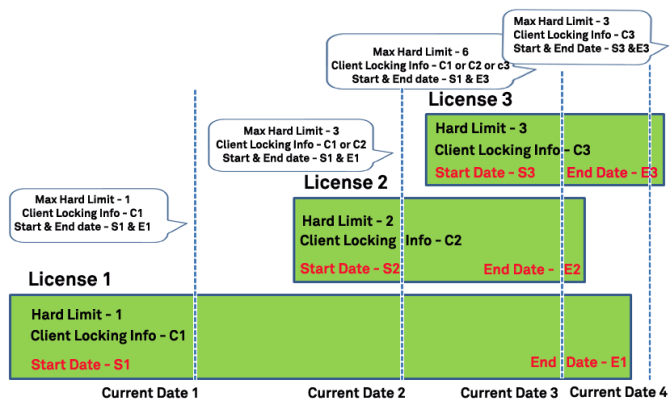Aggregate Licenses in the License Manager Table
When two or more aggregate licenses are present in the License Manager’s memory, they are added together and form a single feature node in the license table.
The feature node will contain an aggregated license state which is governed by the following rules:
>The hard and soft limits defined within the individual licenses will be summed. Therefore, the maximum number of allowed license tokens (or seats) is defined by the combined hard limit at any given point.
>A token which is issued to an application will always hold the earliest start date and the latest expiry date (end date) defined within all of the combined licenses.
>Aggregate licenses which have start dates set in the future can still be loaded onto the License Manager, however, they cannot be requested or aggregated until their start date has been reached.
>The aggregated state in the license table is designed to change dynamically. As new licenses reach their start dates and/or old licenses expire, the aggregated hard limit will change from one day to the next. Any feature-version calls will invoke the process of rebuilding the aggregated state.
•An aggregated license becomes a part of the aggregation as soon as the license begins with its start date.
•An aggregated license is removed from the aggregation as soon as the license reaches its end date.
•When multiple licenses are installed onto the License Manager, and all have start dates sometime in the future, the license with earlier start date will be preferred over those that have later start dates.
•When a license start date is reached and the license becomes current (and it has not expired), its priority will be set higher than any licenses with start dates that are still in the future.
•Once a license has expired, it will automatically be assigned a lower priority than any current or future date licenses.
•When considering other license models, an aggregate license has a lower priority than an exclusive license, but a higher priority than an additive license.
>If client locking codes are used in aggregate licenses, then the client locking information defined within various licenses will be appended. A client which matches the locking information defined in any of the individual licenses will be entitled to use the aggregated license.
>A single aggregate license behaves the same as an exclusive license.
>Applications licensed using RMS client libraries earlier than 8.5.0 will not be able to query or request version 14 aggregate licenses from the License Manager v8.5.0 (or higher).
NOTE The License Manager v8.5.0 (or higher) must be deployed to allow license aggregation. It handles the aggregation/disintegration of licenses seamlessly.
You can understand these points with the help of the following diagram. See the available hard limits on various dates (marked as Current Date in the diagram).
Here are few more examples:
>The hard limit in the duration from S1 to S2 will be 1. The start date in the feature node will be S1 and end date E1.
>The hard limit within the duration from S3 to E2 will be 6 (the aggregated state of all three licenses). The start date in the feature node will be S1 and the end date will be E3.
>The hard limit within the duration from E1 to E3 will be 3 (only license 3 is in valid state). The start date in the feature node will be S3 and the end date will be E3.

